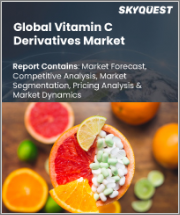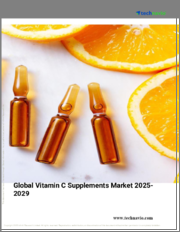
|
시장보고서
상품코드
1360457
세계의 비타민 C 유도체 시장 규모, 점유율 및 성장 분석 : 용도별, 제품 유형별 - 산업 예측(2023-2030년)Global Vitamin C Derivatives Market Size, Share, Growth Analysis, By Application(Food & Beverages, Pharmaceuticals & Nutraceuticals), By Product Type(Ascorbyl Palmitate, Magnesium Ascorbyl Phosphate) - Industry Forecast 2023-2030 |
||||||
세계 비타민 C 유도체 시장 규모는 2022년 1조 2,513억 달러에서 2030년까지 1조 7,583억 6,000만 달러에 이르고, 예측 기간(2023-2030년) 동안 CAGR 4.98%로 성장할 것으로 예상됩니다.
건강에 대한 인식이 높아지고 퍼스널케어 제품에 대한 수요가 증가함에 따라 시장이 성장할 것으로 예상됩니다. 주요 기업들은 안정성과 효능을 높이기 위해 새로운 파생상품을 개발하고 있습니다. 아시아태평양의 소비 확대와 연구 투자가 시장 확대의 원동력이 되고 있습니다. 세계 수요에 대응하기 위해 지속 가능한 원료 조달과 효율적인 생산 방식이 강조되고 있으며, 이 부문의 성장 잠재력은 여전히 유망합니다.
성장 촉진요인
자연주의 성향이 높아지면서 비타민 C 유도체 시장 성장 촉진
스킨케어, 퍼스널케어, 식품, 음료, 보충제 등 다양한 분야에서 천연 및 유기농 제품을 적극적으로 찾는 소비자들이 증가하고 있습니다. 비타민 C를 기반으로 한 유도체는 본질적으로 천연이며 건강상의 이점이 있는 것으로 인식되고 있습니다. 이러한 추세는 다양한 산업 분야에서 활용을 촉진하여 수요 증가와 시장 확대에 기여하고 있습니다.
성장 억제요인
규제의 엄격함과 품질기준으로 인한 시장 성장의 어려움
비타민 C 유도체 생산 및 사용은 엄격한 규제와 품질 기준에 의해 관리되고 있습니다. 따라서 제조업체는 규정 준수 및 규정 준수 측면에서 어려움을 겪을 수 있습니다. 시장 역학은 엄격한 안전성, 유효성 및 라벨링 규제의 영향을 받을 수 있으며, 이는 신규 진출기업에게 진입 장벽이 될 수 있습니다.
시장 동향
개인 위생용품에 유기농 성분을 사용하는 클린 뷰티에 대한 관심이 높아지면서 화장품 및 퍼스널케어 분야에서 비타민 C 유도체에 대한 수요가 증가하고 있습니다. 현대의 소비자들은 자연적이고 지속 가능한 성분을 함유한 제품을 원하고 있습니다. 그 결과, 비타민 C 유도체는 이러한 제품 구성에 있어 매우 중요한 요소로 점차적으로 선호되고 있습니다.
이 보고서는 세계 비타민 C 유도체 시장을 조사 분석하여 시장 역학 및 전망, 부문 분석, 기업 프로파일 등을 제공합니다.
목차
주요 요약
조사 방법
상위 시장 분석
주요 시장 인사이트
- 기술 분석
- 가격 분석
- 공급망 분석
- 밸류체인 분석
- 시장 생태계
- IP 분석
- 무역 분석
- 스타트업 분석
- 원재료 분석
- 혁신 매트릭스
- 파이프라인 제품 분석
- 거시경제 지표
- 주요 투자 분석
- 주요 성공 요인
- 경쟁 정도
시장 역학과 전망
- 시장 역학
- 성장 촉진요인
- 기회
- 성장 억제요인
- 과제
- 규제 상황
- Porter의 Five Forces 분석
- 향후 혼란에 관한 특별한 인사이트
세계의 비타민 C 유도체 시장 : 용도별
- 시장 개요
- 식품 및 음료
- 의약품 및 식이보충제
- 화장품 및 퍼스널케어
- 동물 영양
세계의 비타민 C 유도체 시장 : 제품 유형별
- 시장 개요
- Ascorbyl Palmitate
- Magnesium Ascorbyl Phosphate
- Sodium Ascorbyl Phosphate
- Calcium Ascorbate
세계의 비타민 C 유도체 시장 규모 : 지역별
- 시장 개요
- 북미
- 미국
- 캐나다
- 유럽
- 독일
- 스페인
- 프랑스
- 영국
- 기타 유럽
- 아시아태평양
- 중국
- 인도
- 일본
- 한국
- 기타 아시아태평양
- 라틴아메리카
- 브라질
- 기타 라틴아메리카
- 중동 및 아프리카
- GCC 국가
- 남아프리카공화국
- 기타 중동 및 아프리카
경쟁 구도
- 주요 5개사 비교
- 주요 기업의 시장 포지셔닝(2021년)
- 주요 시장 기업이 채택한 전략
- 주요 성공 전략
- 시장에서의 최근 활동
- 주요 기업의 시장 점유율(2021년)
주요 기업 개요
- DSM Nutritional Products(Netherlands)
- BASF SE(Germany)
- Merck KGaA(Germany)
- Kemin Industries, Inc.(United States)
- Koninklijke DSM N.V.(Netherlands)
- Glanbia Nutritionals, Inc.(Ireland)
- Northeast Pharmaceutical Group(China)
- Shandong Luwei Pharmaceutical(China)
- Zhejiang Tianxin Pharmaceutical(China)
- CSPC Pharmaceutical Group Limited(China)
- Shandong XiYa Chemical Industry(China)
- Natura-Tec(France)
- Greentech S.A.(France)
- Lonza Group AG(Switzerland)
- COFCO Biochemical(Anhui)(China)
- Oy Karlshamn Ab(Sweden)
- Shijiazhuang Donghua Jinlong Chemical(China)
- Hainan Zhongxin Chemical(China)
- Shandong Lianmeng Chemical Group(China)
- Guangzhou Tinci Materials Technology(China)
- Haihang Industry(China)
- Hunan Sunshine Bio-Tech(China)
Global Vitamin C Derivatives Market size was valued at USD 1191.94 billion in 2021 and is poised to grow from USD 1251.30 billion in 2022 to USD 1758.36 billion by 2030, at a CAGR of 4.98%during the forecast period (2023-2030).
The Global Vitamin C Derivatives Market encompasses a range of compounds derived from vitamin C, essential for skincare, pharmaceuticals, and food additives. It is projected to grow due to increasing health awareness and demand for personal care products. Key players are innovating new derivatives to enhance stability and effectiveness. The market's expansion is driven by Asia-Pacific's rising consumption and investment in research. This sector's growth potential remains promising, with a focus on sustainable sourcing and efficient production methods to meet global demands.
Top-down and bottom-up approaches were used to estimate and validate the size of Vitamin C derivatives and to estimate the size of various other dependent submarkets. The research methodology used to estimate the market size includes the following details: The key players in the market were identified through secondary research, and their market shares in the respective regions were determined through primary and secondary research. This entire procedure includes the study of the annual and financial reports of the top market players and extensive interviews for key insights from industry leaders such as CEOs, VPs, directors, and marketing executives. All percentage shares split, and breakdowns were determined by using secondary sources and verified through Primary sources. All possible parameters that affect the markets covered in this research study have been accounted for, viewed in extensive detail, verified through primary research, and analyzed to get the final quantitative and qualitative data
Segmental Analysis
Global Vitamin C Derivatives Market is segmented on the basis of application, product type and region. By application, the market is segmented into food & beverages, pharmaceuticals & nutraceuticals, cosmetics & personal care, animal nutrition. By product type, the market is segmented into ascorbyl palmitate, magnesium ascorbyl phosphate, sodium ascorbyl phosphate, calcium ascorbate. By region, the market is divided into North America, Europe, Asia Pacific, Middle East and Africa, and Latin America.
Drivers
Rising Appetite for Natural Goods to Boost Vitamin C Derivatives Market
Growing numbers of consumers are actively pursuing natural and organic options across diverse sectors such as skincare, personal care, food, beverages, and supplements. With origins in Vitamin C, derivatives from this source are regarded as inherently natural, carrying perceived health advantages. This trend is propelling their utilization across multiple industries, contributing to heightened demand and market expansion.
Restraints
Challenges in Market Growth due to Regulatory Stringency and Quality Standards
Manufacturing and utilization of Vitamin C derivatives are governed by stringent regulatory and quality criteria. This can present difficulties for manufacturers in terms of meeting compliance and adhering to regulations. The market's dynamics might be influenced by rigorous safety, efficacy, and labeling regulations, potentially creating obstacles for new entrants aiming to participate.
Market Trends
The surge in clean beauty preferences, emphasizing the utilization of organic components in personal care items, is propelling the need for Vitamin C derivatives within the realm of cosmetics and personal care. The modern customer is in search of items containing natural and sustainable constituents. As a result, Vitamin C derivatives are progressively gaining traction as a pivotal element in the composition of these products.
Table of Contents
Executive Summary
- Market Overview
- Wheel of Fortune
- Research Methodology
- Information Procurement
- Secondary & Primary Data Sources
- Market Size Estimation
- Market Assumptions & Limitations
Parent Market Analysis
- Market Overview
- Market Size
- Market Dynamics
- Drivers
- Opportunities
- Restraints
- Challenges
- Key Market Insights
- Technology Analysis
- Pricing Analysis
- Supply Chain Analysis
- Value Chain Analysis
- Ecosystem of the Market
- IP Analysis
- Trade Analysis
- Startup Analysis
- Raw Material Analysis
- Innovation Matrix
- Pipeline Product Analysis
- Macroeconomic Indicators
- Top Investment Analysis
- Key Success Factor
- Degree of Competition
- Market Dynamics & Outlook
- Market Dynamics
- Drivers
- Opportunities
- Restraints
- Challenges
- Regulatory Landscape
- Porters Analysis
- Competitive rivalry
- Threat of Substitute Products
- Bargaining Power of Buyers
- Threat of New Entrants
- Bargaining Power of Suppliers
- Skyquest Special Insights on Future Disruptions
- Political Impact
- Economic Impact
- Social Impact
- Technical Impact
- Environmental Impact
- Legal Impact
Global Vitamin C Derivatives Market by Application
- Market Overview
- Food & Beverages
- Pharmaceuticals & Nutraceuticals
- Cosmetics & Personal Care
- Animal Nutrition
- Global Vitamin C Derivatives Market by Product Type
- Market Overview
- Ascorbyl Palmitate
- Magnesium Ascorbyl Phosphate
- Sodium Ascorbyl Phosphate
- Calcium Ascorbate
- Global Vitamin C Derivatives Market Size by Region
- Market Overview
- North America
- USA
- Canada
- Europe
- Germany
- Spain
- France
- UK
- Rest of Europe
- Asia Pacific
- China
- India
- Japan
- South Korea
- Rest of Asia-Pacific
- Latin America
- Brazil
- Rest of Latin America
- Middle East & Africa (MEA)
- GCC Countries
- South Africa
- Rest of MEA
- Competitive Landscape
- Top 5 Player Comparison
- Market Positioning of Key Players, 2021
- Strategies Adopted by Key Market Players
- Top Winning Strategies
- By Development
- By Company
- By Year
- Recent Activities in the Market
- Key Companies Market Share (%), 2021
- Key Company Profiles
- DSM Nutritional Products (Netherlands)
- Company Overview
- Business Segment Overview
- Financial Updates
- Key Developments
- BASF SE (Germany)
- Company Overview
- Business Segment Overview
- Financial Updates
- Key Developments
- Merck KGaA (Germany)
- Company Overview
- Business Segment Overview
- Financial Updates
- Key Developments
- Kemin Industries, Inc. (United States)
- Company Overview
- Business Segment Overview
- Financial Updates
- Key Developments
- Koninklijke DSM N.V. (Netherlands)
- Company Overview
- Business Segment Overview
- Financial Updates
- Key Developments
- Glanbia Nutritionals, Inc. (Ireland)
- Company Overview
- Business Segment Overview
- Financial Updates
- Key Developments
- Northeast Pharmaceutical Group (China)
- Company Overview
- Business Segment Overview
- Financial Updates
- Key Developments
- Shandong Luwei Pharmaceutical (China)
- Company Overview
- Business Segment Overview
- Financial Updates
- Key Developments
- Zhejiang Tianxin Pharmaceutical (China)
- Company Overview
- Business Segment Overview
- Financial Updates
- Key Developments
- CSPC Pharmaceutical Group Limited (China)
- Company Overview
- Business Segment Overview
- Financial Updates
- Key Developments
- Shandong XiYa Chemical Industry (China)
- Company Overview
- Business Segment Overview
- Financial Updates
- Key Developments
- Natura-Tec (France)
- Company Overview
- Business Segment Overview
- Financial Updates
- Key Developments
- Greentech S.A. (France)
- Company Overview
- Business Segment Overview
- Financial Updates
- Key Developments
- Lonza Group AG (Switzerland)
- Company Overview
- Business Segment Overview
- Financial Updates
- Key Developments
- COFCO Biochemical (Anhui) (China)
- Company Overview
- Business Segment Overview
- Financial Updates
- Key Developments
- Oy Karlshamn Ab (Sweden)
- Company Overview
- Business Segment Overview
- Financial Updates
- Key Developments
- Shijiazhuang Donghua Jinlong Chemical (China)
- Company Overview
- Business Segment Overview
- Financial Updates
- Key Developments
- Hainan Zhongxin Chemical (China)
- Company Overview
- Business Segment Overview
- Financial Updates
- Key Developments
- Shandong Lianmeng Chemical Group (China)
- Company Overview
- Business Segment Overview
- Financial Updates
- Key Developments
- Guangzhou Tinci Materials Technology (China)
- Company Overview
- Business Segment Overview
- Financial Updates
- Key Developments
- Haihang Industry (China)
- Company Overview
- Business Segment Overview
- Financial Updates
- Key Developments
- Hunan Sunshine Bio-Tech (China)
- Company Overview
- Business Segment Overview
- Financial Updates
- Key Developments

















